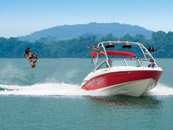Learning the backside lipslide will give you a good base for more technical grinds down the road. Before you progress to the rail, get comfortable holding the slide position by sliding across the surface of the water at 12-15 mph. As a result of the water pressure against the board, you can lean over your toes much more on the water. If you lean too far on a rail, however, you’re sure to slip out over your toes for a nasty fall. Hold the slide across the water with your body positioned straight over the board – to the point where you almost catch your heel edge. Once you’re comfortable on the water, take the same position and handle movements to your favorite flat rail and lock into the most technical of the four base slides. – Kyle Schmidt, Head Coach, The Wakeboard Camp
- Edge away from the wake toward the rail on your heelside edge for a backside approach. Time your edge out so your momentum is moving outward.
- Flatten off before you get to the rail, so you can ollie without too much pressure on the rope. If you hold your edge too long, it will be hard to ollie and turn your body into the slide.
- As you flatten off, drop your back hand and move your upper body and shoulders in line with your feet and the board. This puts you in an ideal setup position to ensure you make it across the entire rail.
- As you ollie off the water, push the handle backside so your body and the board rotate 90 degrees into the backside slide position.
- Land low as the board hits the rail. The lower you stay, the less chance you have of falling over your toes or heels. Turning the handle upside down may help you hold the slide position.
- Make sure you stay straight over the board, and try to keep the rail centered between your feet as you slide. To compensate for any misalignment, lean over the nose or tail to stay balanced.
- As you fall off the end of the rail, let your body untwist naturally back toward your regular stance, absorb your landing, and then edge out of the trick slightly on your heels for stability.
Rob Jacques
Content provided by www.wakeboardingmag.com
